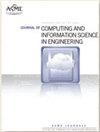A deep convolutional neural network-based method for self-piercing rivet joint defect detection
IF 2.6
3区 工程技术
Q2 COMPUTER SCIENCE, INTERDISCIPLINARY APPLICATIONS
Journal of Computing and Information Science in Engineering
Pub Date : 2023-10-12
DOI:10.1115/1.4063748
引用次数: 0
Abstract
Abstract The self-pierce riveting process for alloy materials has a wide range of applications in the automotive manufacturing industry. This will not only affect the operation performance, but also cause accidents in severe cases when there are defects in the riveted parts. A deep learning detection model is proposed that integrates atrous convolution and dynamic convolution to identify defects of self-piercing riveting parts efficiently to overcome the problem in quality inspection after the body self-piercing riveting process. Firstly, a backbone network for extracting riveting defect features is constructed based on the ResNet network. Secondly, the center area of each riveting defect is located preferentially by the center point detection algorithm. Finally, the bounding box of riveting defects is regressed to achieve defect detection based on this central region. Among them, atrous convolution is used in the external network to increase the receptive field of the model, which combined with an active convolution so that a dynamic atrous convolution module is designed. This module is used to enhance the correlation between feature points of individual pixel in the image, which helps to identify defects with incomplete image edges and suppress background interference. Ablation experiments show that the proposed method achieves the highest accuracy of 95.7%, which is 3.6% higher than the original method. It is found that the proposed method is less affected by the background interference from the qualitative comparison. Moreover, it can also effectively identify the riveting defects on the surface of each area.基于深度卷积神经网络的自穿孔铆钉接头缺陷检测方法
合金材料的自刺铆接工艺在汽车制造业中有着广泛的应用。这不仅会影响操作性能,严重时铆接件存在缺陷时还会造成事故。针对车身自穿孔铆接后的质量检测问题,提出了一种融合了动态卷积和动态卷积的深度学习检测模型,有效地识别自穿孔铆接零件的缺陷。首先,基于ResNet网络构建铆接缺陷特征提取骨干网络;其次,利用中心点检测算法优先定位各铆接缺陷的中心区;最后,对铆接缺陷的边界框进行回归,实现基于该中心区域的缺陷检测。其中,在外网络中使用亚属性卷积来增加模型的接受野,并结合主动卷积设计了动态亚属性卷积模块。该模块用于增强图像中单个像素特征点之间的相关性,有助于识别图像边缘不完整的缺陷,抑制背景干扰。烧蚀实验表明,该方法达到了95.7%的最高精度,比原方法提高了3.6%。定性比较表明,该方法受背景干扰的影响较小。此外,它还可以有效地识别各个区域表面的铆接缺陷。
本文章由计算机程序翻译,如有差异,请以英文原文为准。
求助全文
约1分钟内获得全文
求助全文
来源期刊
CiteScore
6.30
自引率
12.90%
发文量
100
审稿时长
6 months
期刊介绍:
The ASME Journal of Computing and Information Science in Engineering (JCISE) publishes articles related to Algorithms, Computational Methods, Computing Infrastructure, Computer-Interpretable Representations, Human-Computer Interfaces, Information Science, and/or System Architectures that aim to improve some aspect of product and system lifecycle (e.g., design, manufacturing, operation, maintenance, disposal, recycling etc.). Applications considered in JCISE manuscripts should be relevant to the mechanical engineering discipline. Papers can be focused on fundamental research leading to new methods, or adaptation of existing methods for new applications.
Scope: Advanced Computing Infrastructure; Artificial Intelligence; Big Data and Analytics; Collaborative Design; Computer Aided Design; Computer Aided Engineering; Computer Aided Manufacturing; Computational Foundations for Additive Manufacturing; Computational Foundations for Engineering Optimization; Computational Geometry; Computational Metrology; Computational Synthesis; Conceptual Design; Cybermanufacturing; Cyber Physical Security for Factories; Cyber Physical System Design and Operation; Data-Driven Engineering Applications; Engineering Informatics; Geometric Reasoning; GPU Computing for Design and Manufacturing; Human Computer Interfaces/Interactions; Industrial Internet of Things; Knowledge Engineering; Information Management; Inverse Methods for Engineering Applications; Machine Learning for Engineering Applications; Manufacturing Planning; Manufacturing Automation; Model-based Systems Engineering; Multiphysics Modeling and Simulation; Multiscale Modeling and Simulation; Multidisciplinary Optimization; Physics-Based Simulations; Process Modeling for Engineering Applications; Qualification, Verification and Validation of Computational Models; Symbolic Computing for Engineering Applications; Tolerance Modeling; Topology and Shape Optimization; Virtual and Augmented Reality Environments; Virtual Prototyping

 求助内容:
求助内容: 应助结果提醒方式:
应助结果提醒方式:


